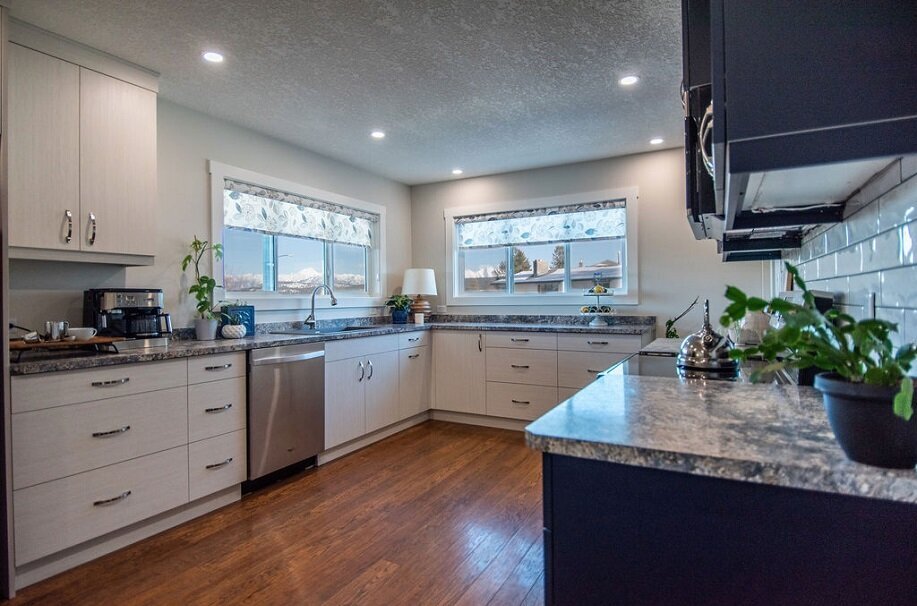Design by Numbers: Must-Know Dimensions for Your Kitchen & Dining Room
How much space should be between your countertop and cabinets? How long should you hang the light fixture in your dining room? How wide should your refrigerator be? These are just a few of the many questions you might have if you're updating your home… and I have answers for you!
Today, I'm going to show you several guidelines for determining the dimensions of various aspects of a dining room and kitchen. No matter your home or lifestyle, these dimensions are standard in the world of design and will make designing your home much easier.
So, grab a notebook and pencil, because you’ll need these numbers to get started on your next kitchen and dining room project.
P.S. If you’re looking for living room dimensions, you can get the Living Room Design by Numbers guide at the bottom of this post!
Design By Numbers: Dining Room
Dining Room Lighting
This is one of the most common mistakes I see in clients’ homes: if a fixture is hung too low, it interferes with your ability to see the person sitting directly across from you. Or, the light hits you right in the eye, causing you to squint over your evening meal.
On the flip side, your light fixture can also be hung too high, in which case you might not be getting enough ambient light at your dinner table.
Here’s what you need to know: This simple measurement isn't about how high or low your light fixture is hung from the ceiling. It's about the distance between the bottom of the light fixture and the top of your dining table.
My recommendation is 30"-35" between those two points. That’s the magic number. Try it!
Dining Room Rug
Not everyone likes a rug in their dining room, but finding the perfect fit can be tricky for those who do. Is there such a thing as a too-large rug in the dining area? Sure, but it's not nearly as problematic as when the rug is too small.
Here’s what happens when the rug is too small… it makes your room look awkward, and functionally, your chair’s legs will most likely get caught on the rug when you sit down and scoot it in. Over and over again, meal after meal. How frustrating!
Here’s what to do: You want a rug that is large enough to be able to move your chair in and out easily. If you pull out the chair, all four chair legs should still be on the rug. So, what’s the perfect measurement?
The perfect measurement for the rug is to make sure there are 24" on every side from the edge of the dining table to the outside edge of the rug.
Wondering about rugs in the living room? Download the living room guide a the end of this post to get the right rug measurements for your living space.
Design By Numbers: Kitchen
Barstool Height
The key to selecting the correct barstool height is that every person needs enough room to move freely while seated, as well as move easily in and out of the seat when they need to freshen up. If you've ever felt like you were trapped in your seat, either at a bar or someone's island, you'll understand that this number matters a lot.
So what's the magic number?
I like 24" from the centre of a stool to the centre of the adjoining stool. Plenty of room, but not so much that it’s being wasted.
Standard Appliance Dimensions
Appliance heights, depths, and widths can vary, and in some cases, the variance is quite a bit. If you haven't thought about this before you arrive at your local appliance store, you'll likely be overwhelmed with all the choices available… and you certainly don’t want to invest in the wrong one.
To make the right choice, you first need to understand how much space you have in your design for the refrigerator, dishwasher, and range. For instance, while 30" is the standard width for a range, there are various other sizes that might work better in your space.
Here's an easy visual to help you understand the standard measurement of each of those appliances:
Take some time to understand the layout you want and the options you have when choosing the size of your appliances. If it helps, draw out a simple sketch to get a better visual of how it will flow together. Better yet, book a consultation with me, and we will map out your kitchen for optimal flow, proper dimensions, and zero buyer’s remorse.
P.S. You can also learn how to estimate the budget for your kitchen renovation here.
Cabinetry and Countertops
There are set industry standards when it comes to kitchen dimensions that will keep your traffic flowing smoothly and your workspace functional.
I know it’s tempting to get creative, but ignoring these standard dimensions will lead to problems both aesthetically and practically. If you're always bumping into your sous-chef at the island, you'll know that these spaces are important and need to be accurate for daily ease and enjoyment.
Planning your upper cabinetry? There is more than one option available for upper cabinet heights. If you're managing your own renovation make sure you know your ceiling height and plan accordingly. For example, you won't want to use cabinetry designed for a standard 8' ceiling if you have a 9' ceiling... if you do, you'll be giving away a lot of usable space up there.
Regardless of ceiling height, the distance between the countertop and the bottom of the upper cabinets will remain the same at 18". Where you will expect to see a change is that 8' ceilings look best with a 36" upper, while a 9' ceiling height can take a 42" upper cabinet.
Again, this is where working with a professional can save you time, headaches, and your investment by helping you make the right decisions for your space and lifestyle.
Regardless of ceiling height, your lower cabinets will always have a standard depth of 24" plus another 1.5” of counter overhang and height of 36” with a countertop of approximately 1.5" thickness. At least that’s one dimension that stays the same! “
That’s it for now, but if you’re looking for more “Design by Numbers” advice for all things living room, you can subscribe to my email list and download my jam-packed guide here.
Or, if you’re ready to update your home, I would be delighted to assist you. I invite you to reach out to me here. With some thoughtful planning, strategy, and a dedicated team, we can bring ease and beauty into your renovation and into your everyday life.
Cheers,
Adrienne
All photos by Stephanie Moore Photography








